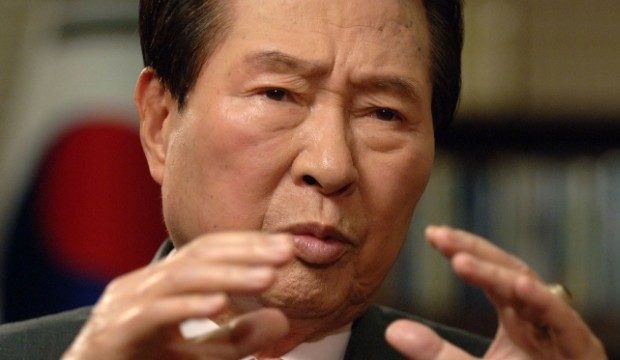
In the Western Pacific region, there are typically four stages in the development of a tropical cyclone, classified by their maximum sustained wind speed—typhoon, severe tropical storm, tropical storm, and tropical depression in the descending order of wind speed.1 On November 1, 1991, for example, a tropical depression was identified in the western Pacific Ocean with estimated winds of forty-five kilometers per hour (km/h) (thirty miles per hour [mph]). Three days later, it was upgraded to a tropical storm with peak winds reaching approximately eighty km/h (fifty mph), which soon made landfall in Samar, the fourth-largest island in the Philippines. Torrential rainfall resulted in catastrophic events such as dam failures, landslides, and flash flooding, which in turn caused approximately 6,000 casualties. Locally known as Tropical Storm Uring, it is recorded as one of the deadliest tropical cyclones in the history of the Philippines.2
Fast-forward to May 2009 in the same country. Filipinos had just bid farewell to Typhoon Kurija, but were preparing themselves for another typhoon (Emong). Less than a week earlier, Typhoon Kujira produced torrential rainfall and created mudslides that killed at least twenty-seven people in the country’s eastern province of Sorsogon. On May 7, the Joint Typhoon Warning Center assessed Emong to have reached its peak intensity, packing sustained winds of 160 km/h (105 mph). Later on the same day, Emong made landfall on the west coast of Luzon, the largest and most populous island in the Philippines. A forty-eight-hour rainfall was recorded throughout Luzon from May 6 to 8. The Philippine government officially reported sixty deaths and thirteen missing. Compared to Tropical Storm Uring, however, it might be a consolation of sorts. Typhoon Emong, although much stonger than Uring, caused only one-hundredth of the casualties caused by Uring.
What could possibly account for such a large difference? One significant reason is that residents of Bolinao were benefiting from accurate storm warnings issued by the Philippine Atmospheric, Geophysical, and Astronomical Services Administration (PAGASA). The PAGASA also relied on the speed of the cyberinfrastructure called the Trans-Eurasia Information Network (TEIN) for the transfer of global meteorological data essential to the timely forecasting of possible disasters. Well before Typhoon Emong reached Bolinao, emergency teams had been issuing text message alerts, patrolling the town, warning people with loud hailers, moving residents to evacuation centers, positioning heavy lifting equipment, and delivering food to distribution points. The early warning made possible by networks including TEIN effectively reduced casualties both from the typhoon and its aftermath.3
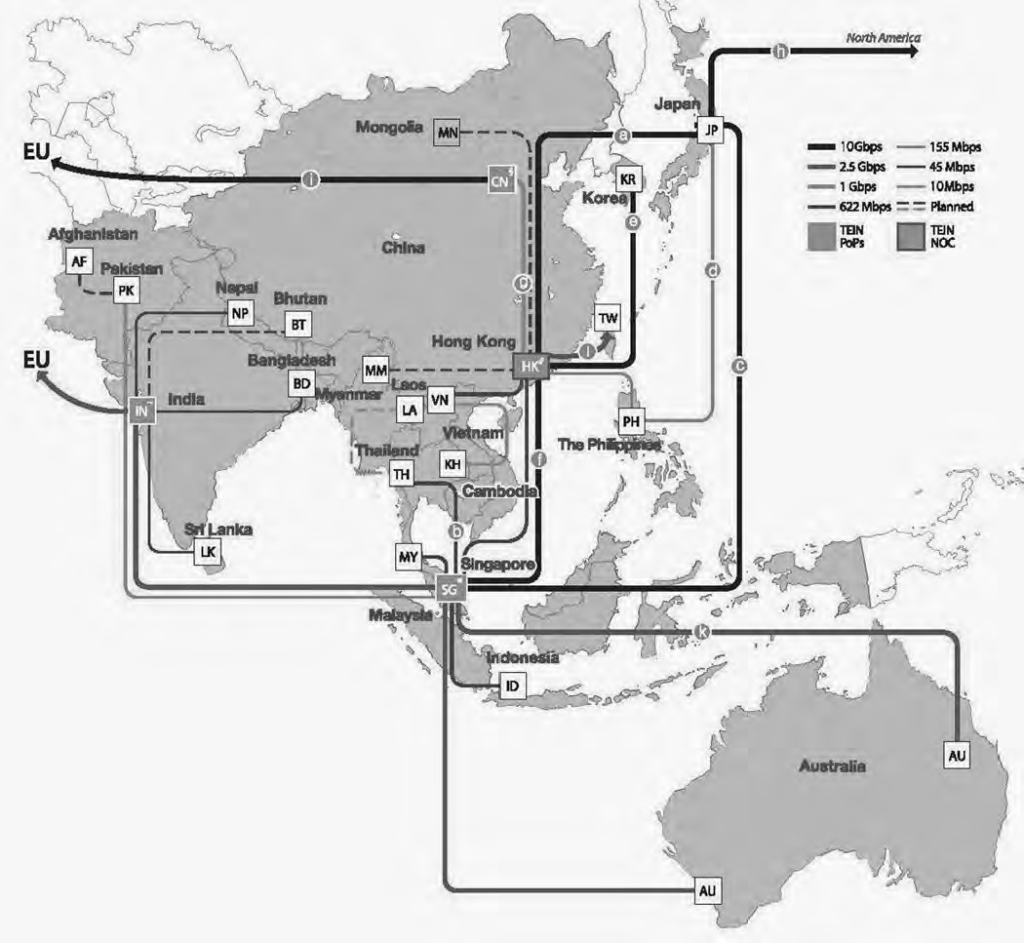
Kim Dae-jung, the eighth President of South Korea (1998–2003), envisioned and stimulated the development of TEIN. In March 2000, while on a ten-day tour of the Western European nations of Italy, Vatican City, France, and Germany, aimed at strengthening Seoul’s economic ties with the European Union, President Kim proposed interconnectivity between European and Asian research and education networks. The connection that he envisioned would be between Asia and Europe. Based on this notion, he proposed the idea at the third summit meeting of interregional institutions of Europe and Asia, the Asia-Europe Meeting (ASEM), in October 2000, which officially endorsed TEIN as one of sixteen ASEM initiatives.4 TEIN has gone through four phases (i.e., TEIN is currently known as TEIN4) since its launch as a single circuit between France and Korea in 2001. The growing support of Europe and Asia has helped TEIN become the largest research and education network in the world today.5
With over fifty million users, TEIN4 currently connects universities and research centers in twenty-three Asian countries, including China, India, Japan, and South Korea (Figure 1). It also connects the forty million European researchers and academics served by the GÉANT network and the pan-European cyberinfrastructure connecting forty-three national research and education networks (Figure 2). TEIN4 supports research collaborations between Europe and Asia in various areas such as earth observation, climate research, crop research, radio astronomy, delivery of e-health (telemedicine), and e-learning.6Kim’s vision has become a reality.
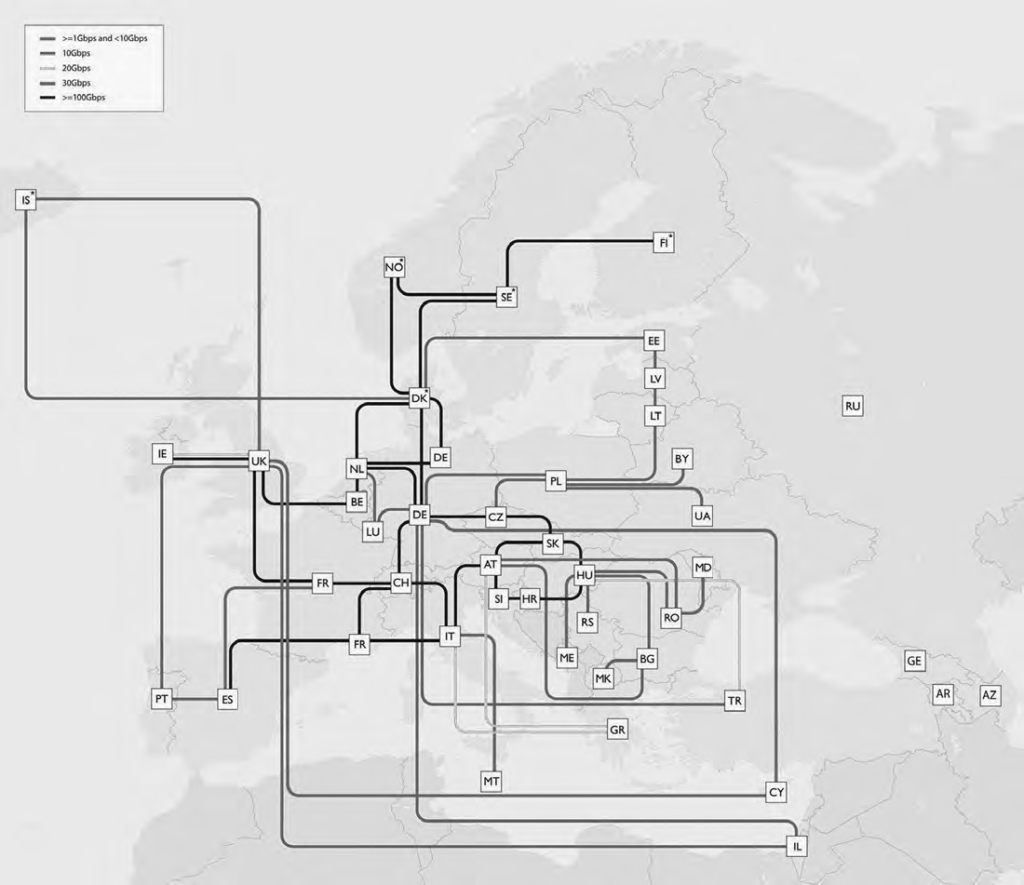
What is cyberinfrastructure? First used by the US National Science Foundation (NSF), the term is commonly used but lacks a precise definition. One much-utilized definition follows:
The newer term “cyberinfrastructure” refers to infrastructure based on distributed computer, information, and communication technology. If infrastructure is required for an industrial economy, then we could say that cyberinfrastructure is required for a knowledge economy.7
Cyberinfrastructure has been a central theme of developing and delivering tools to enhance scientific discovery. As a result, it is often called e-science or e-research. TEIN has been designed to be cyberinfrastructure from the beginning. As proposed during his tour of European countries back in March 2000, Kim’s idea was to start linking the trans-European network of research institutes and its Asia-Pacific counterparts with a super-high-speed telecommunications network.8 At ASEM 3, he stressed that sharing of knowledge in science and technology, as well as in other areas of information and communications, should be strengthened between Europe and Asia, while working toward minimizing the digital divide between nations.9 Considering excerpts from the concept paper for the TEIN project, which was submitted to the same ASEM meeting for approval, reflects Kim’s original vision:
The present proposal for the Trans-Eurasia Information Network Project promises to be a useful vehicle for promoting closer ASEM cooperation through exchanges of information between the two regions. It will be a valuable opportunity to promote interregional research cooperation, and thereby contribute to the knowledge stock and welfare of humankind . . . .
The objectives of this proposal are as follows: a) contribute to enhancing exchanges and cooperation between Asia and Europe through increased and more effective information flows; b) enhance and diversify research exchanges and cooperation between Asia and Europe; c) expand and diversify speedier and more powerful telecommunication connections between Asia and Europe.10
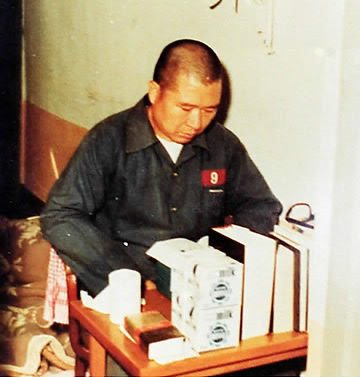
Where did Kim get the idea for this digital infrastructure endeavor? In a previously published EAA article on Kim, Korea specialist Ed Baker recounted Kim’s 1980 conviction for plotting rebellion and death sentence that was commuted to life imprisonment in late January 1981, only through Pope John Paul II’s petition and US government intervention.11 Kim was convicted in 1980 and was sentenced to death. Kim’s widow, Lee Hee-Ho, wrote in her autobiography that when the fear of death disappeared, Kim asked her to send more books for him to read in prison. When waiting to be executed, Kim read mostly about Catholicism and other religion studies topics. After his sentence was commuted, Kim voraciously read books on a variety of subjects, including history, philosophy, economics, and national defense and he also read classic novels. She recounts that her late husband read about 600 books during his two and half years in prison and that she had never seen anyone so relentless in his thirst for knowledge.12One of the books Kim did not request but his wife selected was Alvin Toffler’s The Third Wave.13
Kim Dae-jung mentioned the book many times publicly and in his autobiography, asserting that The Third Wave was the inspiration that gave him a future dream of making Korea an “ICT (information and communications technology) powerhouse.”
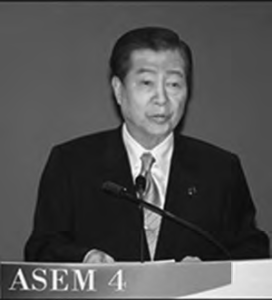
Kim Dae-jung mentioned the book many times publicly and in his autobiography, asserting that The Third Wave was the inspiration that gave him a future dream of making Korea an “ICT (information and communications technology) powerhouse.” Toffler argues in his book that although the Second Wave Society is industrial and based on mass production, mass distribution, and mass consumption, the coming Third Wave Society will be driven by information, knowledge, and creativity. “Yes, this is it!” Kim exclaimed in prison. He confessed his prison cell was a small but great university for him.14
A perusal of Toffler’s description of South Korea in his two books, The Third Wave (1980) and Revolutionary Wealth (2006), illustrates how much the ROK changed in twenty-five years.15 In The Third Wave, South Korea had been portrayed as succeeding in establishing a Second Wave Society, characterized as having the nuclear family, a factory-type education system, and the corporation. Contrast the former description with the following paragraph from Revolutionary Wealth:
President Kim Dae-jung in South Korea, who served on the National Committee on Science and Technology before his election, approved $1.1 billion in funds for nanotechnology research. Once in the Blue House, he campaigned successfully to make his country a world leader in the application of IT and broadband communications—which it is today.16
Kim Dae-jung’s affection for TEIN was manifested many times even after it was launched. At the European Parliament in 2001, the fourth summit of ASEM in Copenhagen, Denmark, in 2002 and on many other occasions, his convictions about cyberinfrastructure became only stronger, more specific, and more realistic. As the first leader from Asia who gave a speech at the European Parliament, he described TEIN as a “cyber Silk Road” realizing “e-Eurasia.”
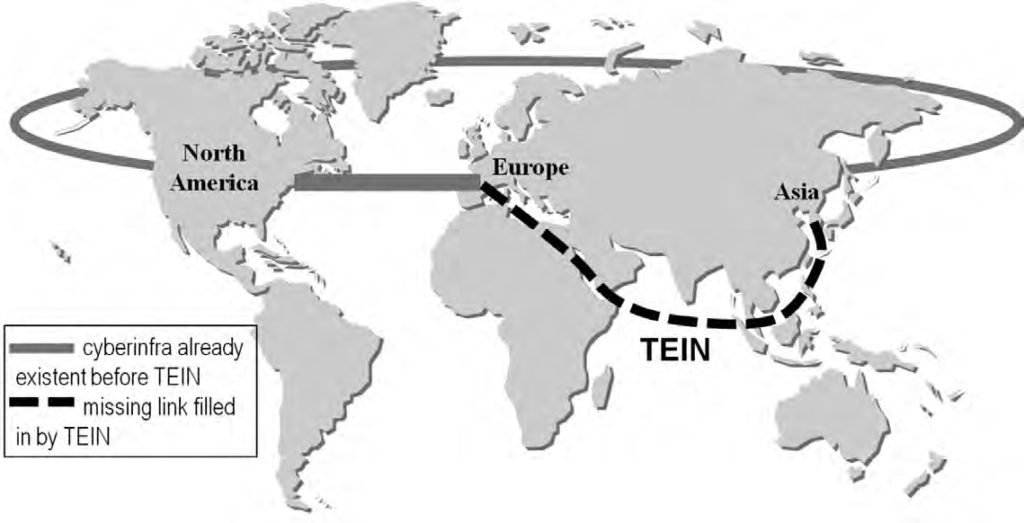
The TEIN project did not always go so smoothly; it wasn’t until the network was finally activated between France and South Korea in 2001 that success began to be attained. I’ll never forget the day when I joined the TEIN planning meeting at the Ministry of Information and Communication (MIC) in Seoul, South Korea, in April 2000.17 It was right after Kim came back to Korea upon the conclusion of his European tour. The MIC was already designated the ministry responsible for the TEIN project. Meeting participants were all experts in cyberinfrastructure and researchers doing e-science. From the beginning, there was a lot of skepticism as to whether there would be sufficient demand for cyberinfrastructure between Europe and Asia. Perhaps it is not surprising that the group’s priority was to have more bandwidth to North America, particularly the United States, and not Europe. There was also strong objection to the idea that the TEIN should directly network Europe and Asia without passing through North America. Since many more undersea cables existed between Asia and North America than between Asia and Europe, it cost much less to network Europe and Asia with North America in between than to network the two regions directly. Another argument for this position was that if the network went through North America, it would provide access to North American researchers and their European counterparts. The debate became furious, but it was not possible to modify Kim’s original proposal.
The debate became furious, but it was not possible to modify Kim’s original proposal.
Fifteen years have passed since then, and now it is clear that apprehensions were baseless. In contrast to the skepticism about insufficient demand, TEIN has been increasingly in demand from both Europe and Asia. As for the issue of direct connection with Europe or passing through North America, it turned out that European partners also welcomed the idea of direct connection. When TEIN2 began in May 2004, European representatives established the first objective to be increases in “direct” connectivity for research and education between Europe and Asia.18 Indeed, as seen in Figure 3, there were high expectations from both regions for TEIN to forge the missing portion of the globally networked cyberinfrastructure from the beginning. Emphasis for the direct link between Europe and Asia has been consistent throughout the development of TEIN3 and TEIN4. The demand of Asian researchers for collaboration with North America was being satisfied by other cyberinfrastructures, such as Asia-Pacific Advanced Network (APAN).
TEIN is not only deeply institutionalized but also highly acclaimed in the ASEM. At the very last summit of ASEM in Milan, Italy, in October 2014, the heads of state for fifty-one Asian and European countries, including the President of the European Council, the President of the European Commission, and the Secretary-General of ASEAN, officially acknowledged the progress of TEIN as follows:
Leaders also welcomed progress in the Trans-Eurasia Information Network (TEIN), as well as the role of the TEIN Cooperation Centre in the Republic of Korea, and reiterated their further support for the project’s implementation. Leaders also underlined the opportunity to leverage the e-infrastructure developed under TEIN for new Asia-Europe projects in areas such as e-learning, e-science, e-health, and e-government. They welcomed the opportunity for further exchanges on cyber issues at the Global Conference on Cyberspace in April 2015 in The Hague, the Netherlands.19
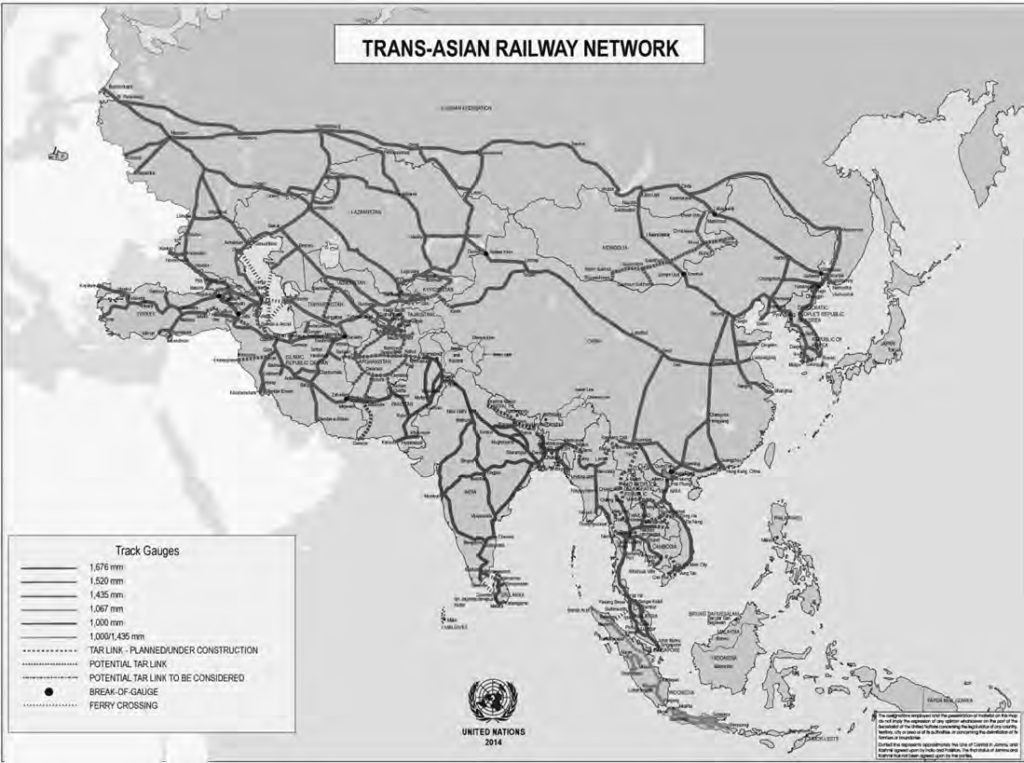
But to Kim Dae-jung, TEIN was only one side of the coin. If one side was described as a cyber or digital Silk Road, the other side of the coin was the iron Silk Road— an integrated railway network across Europe and Asia. For example, at ASEM 4, Kim explained how the iron Silk Road could make it possible for trains departing from Europe to cross the Eurasian continent to arrive in Korean destinations such as Seoul and Pusan, one of the world’s largest container ports and a gateway to the Pacific.20 His vision was that manufactured goods from Japan and other countries in the Pacific would pass through the Korean Peninsula to be delivered to all parts of Europe (Figure 4), saving up to 20–30 percent in time, transportation, and logistical costs compared to exclusively maritime transportation. Safe delivery would also be guaranteed.21 To make the iron Silk Road complete, he suggested building a Japan-Korea undersea tunnel.22 In fulfilling this idea, one of the greatest obstacles would be the linking and stable operation of the railway between North and South Korea. This railway has been cut off for more than fifty years at the Demilitarized Zone since the end of Korean War.
Kim’s entire vision of digital and iron Silk Roads seems to have come from his quest for unity and peace.
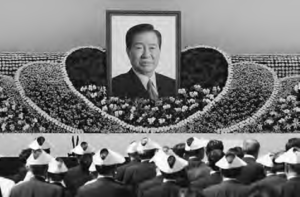
Kim’s entire vision of digital and iron Silk Roads seems to have come from his quest for unity and peace. At his Nobel Prize lecture in Oslo, Norway, in 2000, Kim tried to remind the world that linking the severed railway and road between North and South Korea was pivotal for perpetual peace on the Korean peninsula and the prosperity of Europe and Northeast Asia. Closing his speech at the European Parliament in 2001, he both quoted and reinterpreted the words of Rudyard Kipling:
Rudyard Kipling, who received the Nobel Prize for Literature in 1907, once said: “East is East, and West is West, and never the twain shall meet.” But if he were alive today, he would have said instead: “East is West, and West is East, and never the twain shall part.”23
Kim Dae-jung died in Seoul, South Korea, in 2009. But his legacy lives on and thrives, both within and far beyond, Asia and Europe.
1. “Tropical Cyclone Intensity and Impacts,” Australian Bureau of Meteorology, accessed November 12, 2015, http://tinyurl.com/z6b9dso.
2. United States Navy, “1991 Annual Tropical Cyclone Report,” Joint Typhoon Warning Center, accessed November 12, 2015, http://tinyurl.com/hb2fepp.
3. “TEIN3 Case Study: High-Speed Networking: Saving Lives by Typhoon Forecasting,” DANTE, accessed November 8, 2015, http://tinyurl.com/gpg9cn8/.
4. Hang Ryeol Na, “Key Achievements of TEIN1 August 2006,” ASEM InfoBoard, accessed November 8, 2015, http://tinyurl.com/zd4e2su.
5. See the TEIN3 website at http://www.tein3.net/Pages/home.aspx.
6. Ibid.
7. Daniel Atkins, “Revolutionizing Science and Engineering through Cyberinfrastructure: Report of the National Science Foundation Blue-Ribbon Advisory Panel on Cyberinfrastructure.” (2003).
8. Cesar de Prado Yepes, “Towards a Virtual ASEM: From Information to Knowledge,” in eds. Wim Stokhof and Paul Van der Velde, Asian-European Perspectives: Developing the ASEM Process (New York: Routledge, 2001).
9. “Kim Appeals ASEM Leaders to Minimize Adverse Effects of Globalization,” Presidential Archives. Summit Diplomacy News, last modified October 21, 2000, http://tinyurl.com/zz8wxyw.
10. South Korean Government, “Concept Paper for Trans-Eurasia Information Network Project,” (May 2000).
11. Edward J. Baker, “Kim Dae-jung’s Role in the Democratization of South Korea,” Education About Asia 19, no. 1 (2014): 66–71.
12. Hee-Ho Lee, Companion (Seoul: WoongJin ThinkBig, 2008).
13. Alvin Toffler, The Third Wave (New York: William Morrow and Company Inc., 1980).
14. Kim Dae-jung, Autobiography of Kim Dae-jung, Vol. 1 (Seoul: Samin Books, 2010), 442.
15. Alvin Toffler and Heidi Toffler, Revolutionary Wealth (New York: Alfred Knopf, 2006).
16. Toffler, 300.
17. The Ministry of Information and Communication was a ministry of the government of South Korea from 1994 to 2008. It was dissolved on February 28, 2008, and combined with the former Korean Broadcasting Commission to create the Korea Communications Commission.
18. See the TEIN2 website at http://tinyurl.com/z7jc9mm.
19. 10th ASEM Summit, Final Chair Statement, Milan, Italy, October 16–17, 2014, http://www.aseminfoboard.org/.
20. Markku Heiskanen, “The Roh Administration’s Peace and Prosperity Policy and International Cooperation: The Eurasian Dimension, Catalyst for the Korean Reunification Process?,” International Journal of Korean Unification Studies 12, no. 1 (2003): 1–28.
21. Kim Dae-jung, Special Speech “Inter-Korean Relations and the Iron Silk Road” at the Asia-Pacific Business Forum on Transport and Logistics 2006. (November 8, 2006)
22. Michael Baker, “South, North Korea Break Ground for ‘Iron Silk Road,’” The Christian Science Monitor, September 19, 2000, http://tinyurl.com/hemxudt.
23. Kim Dae-jung, “World Peace and EU-ROK Cooperation,” Address at the European Parliament, December 11, 2001, http://tinyurl.com/gugn9vw.

